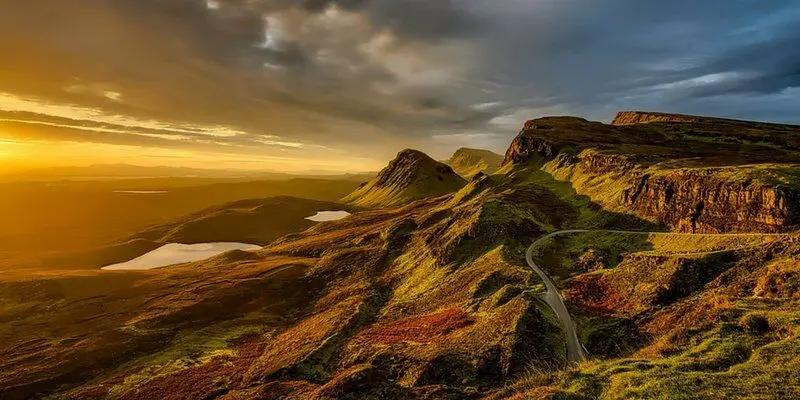A Brief History of Scotland
The long history of the lands of the northern third of Great Britain has been violent and often tragic. The castles and ruins, the songs and the legends tell Scotland’s tale. In this article, we discuss a brief history of Scotland.
It is the harshness of its history and the ruggedness of its land that have shaped the proud Scottish people. How this country came to be, and evolved, has long taxed the minds of many historians.
Earliest People
Archaeological records show that the earliest people (nomadic hunters and gatherers) came to the area over 6,000 years ago, as the last remains of the ice age crept northward. The first recorded history of Scotland was by the Roman historian Tacitus in the first Century A.D., who called the people the Picts, and referred to them as ‘savages,’ and ‘fierce enemies.’
The other founding peoples of Scotland are considered to be the Vikings, the Boernicians, the Dalriadans, the Strathclyde-Britons, and, later, the Normans. It was in order to fight the Romans, that these warring clans began to unite.
The Romans had conquered all the rest of Britain, but were never able to subdue the (Caledonia) clansmen of the north, and in the end, constructed Hadrian’s Wall, an imposing stone barrier stretching from sea to sea to protect them from the marauding of the Picts.
Shortly after 400 A.D., the Romans left the British Isles, and Scotland began to emerge out of the dark ages. There were four peoples inhabiting what was then called Alban – the Picts, the Dalriadan Scots, the Britons, and the Angles –when invasions by Norwegian Vikings began.
By 843, Kenneth MacAlpin, king of the Scots of Dalriada held all lands north of the river Forth, and renamed the land Scotia. Duncan I (portrayed in Shakespeare’s Macbeth) added to this kingdom what is now the rest of mainland Scotland. Although there followed a period of peace with England, warring within Scotland and between Scotland and Norway was constant.
King Edward I
King Edward I of England fought off a Scottish invasion by John Balliol, and then rampaged through Scotland, eventually capturing the ancient stone of destiny, the Stone of Scone, upon which Scottish kings had been crowned for seven centuries. He placed the stone in Westminster Abbey, where it stayed until it was ‘stolen’ by Scottish nationalists in 1950.
The stone was formally returned to Scotland November 15, 1996, and is now on display in Edinburgh Castle. For his exploits, Edward I earned the nickname ‘Hammer of the Scots.’ The Scots continued attempts to free themselves of England’s control. One of Scotland’s greatest national heroes, Robert the Bruce had himself crowned at Scone in1306. His uprising was defeated, but Bruce was not killed.
He became a famed outlaw who harassed the English armies using guerilla tactics and united Scottish noblemen in his cause. By 1314, Bruce had driven the English out of every town in Scotland, but Stirling.
Robert Stewart
In 1371, Robert Stewart became the Scottish king, the first in a long line of Stewarts (later spelt Stuart). There had been several child kings and much strife when James IV came to the throne at age fifteen. He managed to control lowland rebellions and attempted to make peace with the Highland clan chiefs.
In 1502,James IV signed a treaty of perpetual peace with England, and married Margaret Tudor, daughter of King Henry VII of England. Thus paving the way for the eventual union of the crowns.
Mary Queen of Scots
The Royal Stuart line was to come to an end with Mary Queen of Scots, one of history’s most prominent women. Mary became Queen of Scotland when she was just a week old. Henry the VIII arranged for Mary to marry his young son,and so when Mary’s mother rejected this treaty of marriage, Henry responded with a vengeful onslaught of bloodshed, burning and pillaging in Edinburgh and the Border Country.
Mary returned from France at age eighteen, widowed,beautiful, strong-willed and Catholic. Her attempt to rule a Scotland was plagued with difficulties, as Scottish nobles had renounced the Catholic Church in favor
of Protestantism in 1557.
Eventually, Mary was forced to abdicate and her one year-old son James VI was placed on the throne. She fled to England, to her cousin Queen Elizabeth I. Due to her claims to the English thrown, Mary was
imprisoned in the Tower of London, and then beheaded in 1587. The two queens never met, and some historians suggest that Elizabeth was insanely jealous of Mary’s beauty and charm.
James VI
The infant son of Mary, James VI, as he grew continually fought with the Scottish his regents and other nobles to exercise his right to govern. To silence this Catholic King, a Protestant group eventually kidnapped James.
However, in1583, James VI escaped from his kidnappers, and resumed the throne of Scotland. When Elizabeth I died in 1603, James was her only heir; thus he became James I of England, as well as James VI of Scotland. James’ most lasting legacy is the King James Bible; an English translation still favoured by many Protestants.
The union of the crowns did not however put an end to struggles in Scotland. Civil war in England in 1642 pitted the cavaliers fighting for King Charles I against the Roundheads of Oliver Cromwell’s parliament.
Charles I
When the victorious Cromwell forced the execution of Charles I, the Scottish proclaimed Charles’ son as their king. Cromwell, incensed, invaded Scotland, uniting the two countries under a strong, central, civil government. Upon Cromwell’s death, the English Monarchy was restored to the throne.
Many Scots felt they had lost their independence, setting the stage for uprisings. The Jacobites wanted the return to a Stuart king for Scotland, and periodically took up arms to this end. By 1707, the English line of succession had passed to Queen Sophia of the German Hannover family, and a majority of the Scottish Parliament agreed to a union of parliaments and Hanoverian succession, in return for commercial equality, use of their own legal system and the Presbyterian religion.
The Jacobite Rebellion
The Jacobite rebellion grew as did opposition to the union of the parliaments. In 1715, James Edward rallied the Scottish clans around him, and was proclaimed king of Scotland. However, the great families of Scotland were not united, and the uprising was defeated.
Despite attempts by the English to disarm the clansmen and ship Jacobites to plantations in America, the Jacobites rose again. Bonnie Prince Charlie, a handsome and charming man, gradually drew support until he led 3,000 clansmen to Edinburgh to reinstate his father, James Edward, as king of Scotland.
After winning several battles in Scotland, Charles crossed the border and pushed southward toward London. Only a few hundred kilometre from London, a fatal decision was made to withdraw to the highlands in order to raise more troops.
The Clans
Yet Scotland was as divided as ever; many clans supported the Honoverian side. Finally, on Culloden Moor in 1746, Charles’ ragged and hungry Highlanders were slaughtered by the English cavalry. Charles escaped by rowboat to the Isle of Skye, disguised as a maidservant, and even though the English put a price on his head of 30,000 pounds (an incredibly vast sum of money for the time); no one ever betrayed him.
The English response to these uprisings was vengeful and cruel: whole villages were to burn and clansmen were slaughtered or shipped to the plantations. As lowlanders and Englishmen became the landlords, and the clan chiefs became no different from other land holders, the allotted amount of land for sheep pasture increased dramatically, causing what is know as the Highland Clearances.
People were literally cleared off the land to make way for more profitable farming. This turned the trickle of migration out of Scotland into a great wave of settlers, who then pioneered the colonies in North America and Australia.
In fact, the English tried to destroy the clan system with the Disarming Act of 1746: no Scot was allowed to bear arms, and the wearing of clan tartans and even the playing of bagpipes were banned. The penalty for wearing ‘any part whatsoever’ of the Highland dress was six months in jail, for a first offence.
Miraculously, many of the Scottish traditions did survive this period of persecution. Many indeed did flourish as the restrictions were gradually dropped. Today, the clan tartan is one of the world’s most powerful symbols of kinship. Check out our clan histories. Find out if your name has a coat of arms and surname history.



